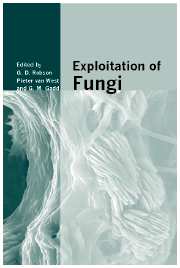Book contents
- Frontmatter
- Contents
- List of contributors
- Preface
- I Comparative and functional fungal genomics
- II Bioactive molecules
- 3 The biosynthesis of polyketides, acyl tetramic acids and pyridones by filamentous fungi
- 4 Fungal metabolites as lead structures for agriculture
- 5 Molecular and genetic analysis of symbiosis expressed secondary metabolite genes from the mutualistic fungal endophytes Neotyphodium lolii and Epichloë festucae
- 6 What can genomics tell us about secondary metabolism in Aspergillus?
- III Protein folding and secretion
- IV Fungal bioremediation
- V Fungal biocontrol of pests
- Index
- References
4 - Fungal metabolites as lead structures for agriculture
from II - Bioactive molecules
Published online by Cambridge University Press: 05 October 2013
- Frontmatter
- Contents
- List of contributors
- Preface
- I Comparative and functional fungal genomics
- II Bioactive molecules
- 3 The biosynthesis of polyketides, acyl tetramic acids and pyridones by filamentous fungi
- 4 Fungal metabolites as lead structures for agriculture
- 5 Molecular and genetic analysis of symbiosis expressed secondary metabolite genes from the mutualistic fungal endophytes Neotyphodium lolii and Epichloë festucae
- 6 What can genomics tell us about secondary metabolism in Aspergillus?
- III Protein folding and secretion
- IV Fungal bioremediation
- V Fungal biocontrol of pests
- Index
- References
Summary
Introduction
In order to meet an increasing food and feed demand for a rising human population agricultural production must be increased, in which crop protection plays a key role. For many decades this field has been the domain of inorganic and synthetic organic chemistry. Many pests could be effectively controlled but high toxicity for humans and non-target organisms as well as in some cases a prolonged persistence in the environment, have made a search for less toxic and more environmentally safe compounds mandatory. The emergence of resistant pathogens, especially fungi, has added to the problem making an intensive search for agrochemicals with new target sites necessary. Today, the standards to be met by new agrochemicals are very high, especially with regard to efficiency and ecological safety. The price has to be competitive and, in general, much lower compared to pharmaceutical compounds. In addition, the active ingredients have to be produced in very large quantities. In 2004, 85 000 tons of agrochemicals were produced in Germany, among them 37 000 tons of fungicides (Hübenthal, 2005).
Natural products in plant protection
Natural products obtained from terrestrial and marine microorganisms, plants and animals are important sources of new chemical structures with biological activities useful for medicine or agriculture. In human medicine the natural products themselves, or semi-synthetic derivatives, play key roles in antibiotic therapy, organ transplantation, cancer therapy and other important fields. In the field of plant protection, their roles are much less conspicuous.
- Type
- Chapter
- Information
- Exploitation of Fungi , pp. 45 - 58Publisher: Cambridge University PressPrint publication year: 2007
References
- 2
- Cited by



